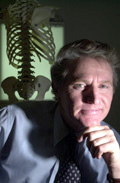Dr David McGrath
Spine Physician
MB BS (Hons) FAFOM, RACP, FAFMMMaster of Pain Medicine
Essays:
Dear patient
I am very pleased to offer you my knowledge in your quest for recovery. At this point in the history of man our knowledge of the skeleton and spine in particular is in its infancy. This may seem strange in an age of advanced technology. In addition, and perhaps as a result of this fact there are bewildering arrays of possible interventions, most of which have a considerable probability of making matters worse or delivering marginal benefits. The more we explore the subject the more complex it becomes.
I involve myself in surgical recommendations, ergonomics, nutrition, needle interventions, pharmacotherapy, risk factor detection and exercise. Mostly I prescribe movements with an approach which could be described as self experiment.
Of particular interest to myself are the overall efficiency and usage patterns of the spine. I have come to the viewpoint that inefficiencies act as intrinsic risk factors for injury and poor recovery.
Unraveling disorder is best accomplished, from my perspective, by conducting a number of movement experiments without any presumption or expectations. In organic structures, however, experiments usually cannot be conducted without simultaneously changing the structure. This is the essential insight needed for a therapeutic intervention which might improve order without the concomitant risk of further disorder. I construct experiments for you on an individual basis although there will be overlap with similar clinical presentations. Success is dependant on the initial degree of disorder, diligence, good selection of movements, lifestyle patterns and other factors (luck)
By creating a system with negligible downside and positive tangible upside, progress is almost certain and progressive.
Many people including myself require a greater understanding than the paragraph above. In order to facilitate a greater appreciation of the complex issue we are dealing with I have further listed a number of metaphors and analogies which act a medium for people of various intellectual backgrounds and capacity. These analogies will also motivate the journey to order and create hope. My articles, are of various related topics and with a spectrum of difficulty.
I am not able to help people with major intellectual dysfunction. The process of experimentation and change requires an intact cognitive system unimpaired by drugs, toxicity and brain damage. An inability to concentrate excludes the possibility of progress through this technique. Concentration itself however, is improvable and may need its own intervention such as medication.
The essential ingredient of each movement experiment is the observation of order or disorder. By moving into order and away from disorder the former is reinforced, allowing a further expansion by an additional experiment involving the same set of components. Increasing order displaces the disorder responsible for nociception and pain.
This technique may not be quick, depending on the degree of difficulty (or luck). Progress is usually steady however. As patterns of disorder breakup and are replaced by ordered movements and postures, pain and discomfort decrease. This is usually experienced as a number of observations including a reduction in the size, intensity and frequency of acute disordered attacks. Once the technique is established by practice of simple routines, further gains can be made by less obvious experiments, reducing the likelihood of other disruptions.
If a serious undiagnosed disorder is present the response is usually atypical leading to investigations. Again the technique has a low probability of making matters worse apart from the prospect of delayed diagnosis. Red flag conditions, as they are often called, can be excluded by proper examination and history taking or if necessary by investigations.
It should be understood that this is a non diagnostic system. It is non reductionist. It is based upon the notion of order and the loss of it leading to disease. Each movement is diagnostic of order or disorder and through consciousness allows the possibility of extending order. We are extending into largely unchartered waters by utilizing this technique but the possibilities seem large and real. It does not share the shortcomings of the diagnostic reductionist approach. A diagnosis may be incorrect, or if correct not have a valid relationship to an effective treatment. This approach is not about things or entities but only relationship which is amenable to conscious input. In this regard there is a shared property with other non diagnostic systems such as manipulation, massage and acupuncture.
Reductionist labels such as prolapsed disc are of secondary importance. The inputs into the system which are generating the prolapse or creating stress across the joint receive more prominent attention. Consciousness itself is blind to such components. An awareness of signals generated by the disc is part of the neural traffic along with multiple other signals both immediate and more distant.
The dominant emotion needed for success is curiosity with some patience. Coercion or effort is not part of this method. I have come to believe that changes to a component which are discordant with interacting structures will be non useful in the medium to long term, if it is not obvious immediately. The method is also synthetic or systemic in that there is no focus upon specific structures which cannot be sensed directly. No action would be directed at muscles or joints. It is the flow of changing relations as sensed by the brain which is the object of attention regardless of the components generating the neural traffic.
With the movement experiment approach, detecting disorder becomes the impulse for its own correction. The change in perspective leads to a fusion of symptoms/diagnosis/treatment within a lower order simplistic process but with some surprising results.
My work builds upon the pioneering work of M Feledenkrais and others who are curious about perception and function. Modern understanding of dynamical systems has also been influential. I have been impressed by the work of H.Maturana a Chilean neuroscientist.
I wish you the very best outcome with a painless future.
Dr David McGrath
10/8/2007
©Copyright 2007 Dr David McGrath. All rights reserved

